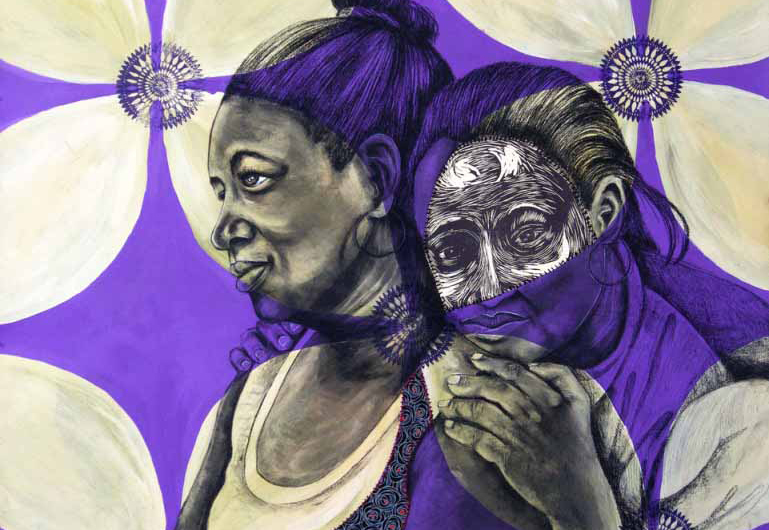
To call Delita Martin’s art merely portraits would be doing them a disservice. Her works stand as inspiring monuments to living and late black women in her family and extended community.
At the core of her exhibition Between Sprits and Sisters—on display at Galerie Myrtis through February 2, 2019—is a desire to “capture the spirit of a person,” as she says, more than just relay a photorealistic representation.
Martin’s unorthodox approach to portraiture and distinctive aesthetic cleverly juxtapose myriad printmaking techniques with drawing, painting, sewing, and her own symbolic flourishes to create fantastical, spiritually intoned black figures. Martin uses grand embellishments, dense layering of geometric patterns from relief or callograph prints, decorative papers, and hand-stitching to realize intimate scenes of black women’s encounters with ethereal realms.
The worlds Martin illustrates are startlingly beautiful, meditative, and reveal the artist’s ever-expanding mastery of the mediums she engages. We recently talked to the artist about her latest work, spirituality, and the impact of the collection on the canon of portraiture.
What inspired the creation of Between Spirits and Sisters?
It was really a combination of things. Me wanting to grow in my work. It’s always about how do I expand the conversation? How do I continue to talk about the women in my community and the things I want to say and talk about? Also, in terms of working with material, how do I push the envelope as far as processes that I use? I moved from Little Rock back to Texas with my family and I’m interested in how my current environment impacts the work that I have and I’m really allowing that to come through and show in my work.
What’s really beautiful about the work is that those patterns and textures that recur really do create the feeling of another world, a spirit world or otherworldly dimensions. When did you begin to visualize the spiritual world as densely patterned landscapes?
Early on . . . I didn’t want to get in the studio and just be a printmaker or just a painter, or draftsman. I wanted to create, to be an artist. I began to bring all of the different processes together and really marry them. It was really difficult. You learn these different processes in school, but if you are a painter, you are a painter. If you are a printmaker you are a printmaker, I realized that I didn’t have to be any of those things or I could be all of those things.
In terms of the ideas and the development of how did I get the figures in the work, I really began to tell more of my own personal story. Not that other works weren’t personal, but I think that I was concerned with representations of the entire community. But with this body of work you begin to see myself in the work as well as my close family members and extended family. I’m actually drawing them as I see them which was new for me. I never worked from models before and now I am, and its really added a different dimension to the work.
I began to think about how women navigate the spiritual realm. What does it visually look like when we pray? What does it look like when we meditate? What does that look like for me? In terms of the veil, that space between the spiritual and the waking world, what does that look like? The patterns make sense to me.
You’ve spoken about walking into your studio and having a guidance, or hearing a voice, or having the works reveal themselves before they are made.
I am really a vessel or a tool that this message comes through. When I am in the studio, I will come in or have an idea or I will say “I want to work with a full figure.” Or “I want to work with just a portrait today.” That is really as much information as I have when I come into the studio. Once I start working, I may start on the pattern or background first and that determines the figure. Once I get the figure roughed in, I usually start with the facial features and then from that point on everything tells me what to do next.
How do you hope that your work will contribute to the greater canon of portraiture?
I want it start and continue a conversation about what portraiture is and what it means. I’ve always been interested in the figure, drawing the figure and portraits, I didn’t know where I was going with it. I was maybe a sophomore in college and I went on a field trip with my class . . . and we visited stained-glass artist Jean Lacy. We walked into her home and she had all of this beautiful artwork and she had one picture that was a portrait of her done by John T. Biggers. It looked nothing like her, but when you saw it you instantly knew who it was because he had captured her spirit. I knew at that point that was what I wanted to do.
I don’t have an interest in hyper realism. I would use a camera if I did. I’m really interested in capturing that moment, the twinkle in your eye, the slight smile that is known only to you, the simple gesture of your hands. Those are the things I want to capture. I want the essence of who you are.